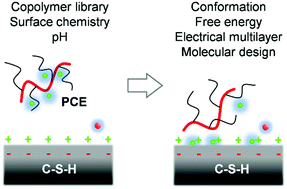Mechanism of molecular interaction of acrylate-polyethylene glycol acrylate copolymers with calcium silicate hydrate surfaces†
Abstract
Obtaining insights into the adsorption and assembly of polyelectrolytes on chemically variable calcium silicate hydrate (C-S-H) surfaces at the atomic scale has been a longstanding challenge in the chemistry of sustainable building materials and mineral–polymer interactions. Specifically, polycarboxylate ethers (PCEs) based on acrylate and poly(ethylene glycol) acrylate co-monomers are widely used to engineer the fluidity and hydration of cement and play an important role in the search for building materials with a lower carbon footprint. We report the first systematic study of PCE interactions with C-S-H surfaces at the molecular level using simulations at single molecule coverage and comparisons to experimental data. The mechanism of adsorption of the ionic polymers is a two-step process with initial cation adsorption that reverses the mineral surface charge, followed by adsorption of the polymer backbone through ion pairing. Free energies of binding are tunable in a wide range of 0 to −5 kcal mol−1 acrylate monomer. Polymer attraction increases for higher calcium-to-silicate ratio of the mineral and higher pH value in solution, and varies significantly with PCE composition. Thereby, successive negatively charged carboxylate groups along the backbone induce conformation strain and local detachment from the surface. Polyethylene glycol (PEG) side chains in the copolymers avoid contact with the C-S-H surfaces. The results guide in the rational design of adsorption strength and conformations of the comb copolymers, and lay the groundwork to explore the vast phase space of C-S-H compositions, surface morphologies, electrolyte conditions, and PCE films of variable surface coverage. Chemically similar minerals and copolymers also find applications in other structural and biomimetic materials.



 Please wait while we load your content...
Please wait while we load your content...